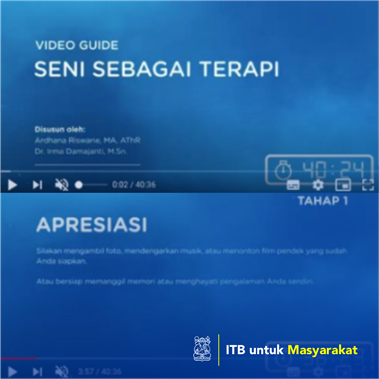

Irma Damajanti
In 2019, an experiment in Group Therapeutic Art was performed within the Visual Art Study Program and there were evidences of visual resonance. They indicate an increased empathy between the subjects, as well as the success in group formation. This year, the experiment module was perfected and ready to be used in a larger context. However, due to the Covid-19 pandemic, the group sessions could not be executed as planned. Bearing the same question, the target and methodology were modified to enable students to use their own creative powers to overcome the current conditions. The main method used in this service is therapeutic art, which is divided into three sub activities: stimulation, creation, and reflection. The appreciation part that embeds a meaning-making process, which is at the heart of therapeutic art, follows Knill’s Aesthetic Analysis. Due to the social distancing, the medium was adapted into a 40-minutes video guide instead of an offline meeting. The activity was conducted within the Psychology of Art course and followed by 120 ITB students from various study programs and Faculties/Schools Through this project, firstly the research paper on the therapeutic uses of art by Visual Art Final Year students is able to be published on the AESCIART proceeding. As mentioned above, a significant finding in this research is that there was an increase in the therapeutic use of art between 2012-2016. Furthermore, we were able to identify students’ use of artwork as containment, sublimation, metaphor and symbol.
Penerapa Karya Seni/Desain/Arsitektur/Perencanaan Wilayah, Penerapan Karya Tulis
In 2017, an increasing tendency in making art for therapeutic purposes was found among the final year students at the Visual Art Study Program, graduated between 2012-2016. In the following year, in a qualitative research conducted on the subjects of students in the elective course of Psychology of Art, it is found that both Visual Art and non-Visual Art students are capable of appreciating artworks, even though they show different qualities. These findings prompted other questions about the psychological needs as well as strengths of students at Institut Teknologi Bandung (ITB) in general. How can we increase their psychological strengths to enable them in overcoming their shortcomings?